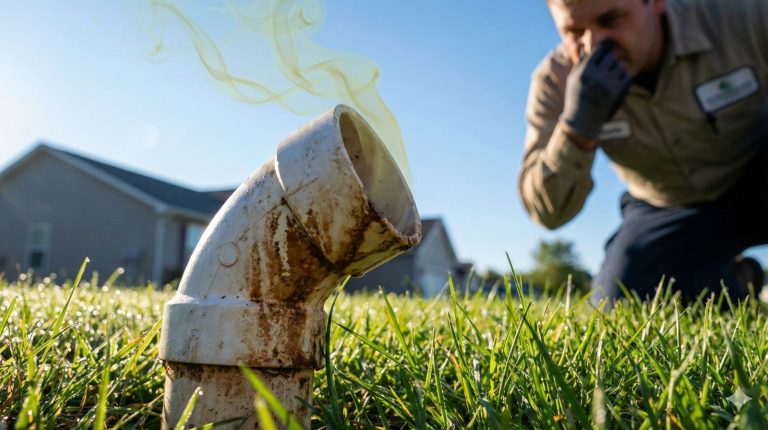Septic tank problems like clogs, foul odors, leaks, root intrusions, and lack of maintenance are common. Slow drainage indicates problems, necessitating regular checks to prevent blockages. Foul odors signal digestion issues and leaks, requiring immediate action to avoid environmental harm.
Gurgling noises and leaks demand immediate repairs to prevent contamination. Root barriers can prevent damage caused by tree roots infiltrating the system. Neglecting maintenance can lead to costly repairs and environmental hazards. Understanding these issues is important for maintaining a functional septic system.
Addressing these challenges promptly promotes a well-functioning system and avoids potential risks. Check out this ultimate solution for your septic tank problems now!
Key Takeaways
- Clogged or slow-draining systems due to solid buildup or blockages.
- Foul odors signal anaerobic issues; hydrogen sulfide causes rotten egg smell.
- Leaks lead to environmental harm; gurgling noises indicate plumbing problems.
- Tree roots damage tanks and pipes; preventive measures are crucial.
- Lack of maintenance causes malfunctions; regular inspections and pump-outs are essential.
Clogged or Slow-Draining Septic Systems
Clogged or slow-draining septic systems pose significant challenges to homeowners due to the accumulation of solids, oils, and grease within the tank. When these substances build up, they can obstruct the normal flow of wastewater, leading to slow drainage or complete blockages within the system. Slow drains are often an early indicator of septic tank issues, signaling potential problems like a full tank or a clogged drainfield, which can ultimately result in backups and overflows.
The root causes of clogged or slow-draining septic systems are often linked to a lack of regular maintenance, including infrequent pumping schedules and improper disposal of non-biodegradable items. Over time, these issues can impede the system’s ability to function properly, causing inconvenience and potential health hazards for residents.
Professional inspection and maintenance play a vital role in identifying and addressing clogging problems before they escalate, ensuring the efficient operation of the septic system and preventing costly repairs. Addressing clogs promptly can help maintain the longevity and effectiveness of the entire septic system.
Foul Odors From Your Septic System
The presence of foul odors emanating from a septic system often serves as a vital indicator of underlying issues related to anaerobic digestion or incomplete waste breakdown. These odors, reminiscent of rotten eggs, are commonly associated with the presence of hydrogen sulfide gas within the septic system.
Such foul odors can result from various issues such as leaks in the septic tank or drainfield, which allow gases to escape into the surrounding environment. Additionally, clogged pipes or a malfunctioning vent system in the septic setup can also contribute to the release of unpleasant odors.
Promptly addressing foul odors is essential not only to mitigate the discomfort they cause but also to prevent further damage and maintain the proper functioning of the septic system. Regular maintenance and timely repairs can help alleviate foul odors and uphold a healthy septic system environment for both your property and surrounding areas.
Septic Tank Leaks And Gurgling Noises
When septic tank leaks occur, they pose a potential risk of environmental contamination and property damage, highlighting the importance of timely detection and resolution.
Leaks in the septic tank can stem from various issues such as cracks, corrosion, or structural damage. These leaks not only compromise the efficiency of the system but can also lead to harmful pollutants seeping into the surrounding soil and water sources.
Gurgling noises emanating from the septic tank are often indicative of blockages or problems within the plumbing system. The presence of gurgling noises suggests that there may be trapped air in the pipes due to obstructions or inadequate venting.
Addressing septic tank leaks and gurgling noises promptly is essential to prevent more severe complications and costly repairs in the future. Regular inspections, maintenance, and timely repairs can help mitigate the risks associated with leaks and gurgling noises in the septic tank, ensuring the longevity and effectiveness of the system.

Septic System Damage From Tree Or Plant Roots
Tree roots pose a significant risk to septic systems as they can infiltrate tanks and pipes, causing structural damage and leaks. Preventive measures such as avoiding planting deep-rooted trees near the system and installing root barriers can help mitigate root intrusion risks.
Regular monitoring and maintenance are vital in identifying and addressing any potential damage caused by tree or plant roots to guarantee the proper functioning of the septic system.
Root Infiltration Risks
Root infiltration poses a significant risk to septic systems, potentially leading to leaks, blockages, and system malfunctions. When tree roots or plant roots intrude into the septic system, they can cause serious damage. Here are key points to take into account:
- Infiltration Points: Tree roots can penetrate septic tanks through walls, pipes, and various components, resulting in leaks and clogs.
- Disruption of Function: Root intrusion disrupts the proper functioning of the septic system, causing backups and potential structural harm.
- Common Issue: Older septic systems or those situated near trees or shrubs are more prone to root infiltration, highlighting the necessity for regular inspections and preventive actions.
Preventive Measures for Roots
To mitigate the risk of damage caused by tree or plant roots to septic systems, implementing preventive measures is essential for ensuring system longevity and functionality. Tree roots have the potential to infiltrate septic system components, leading to leaks, blockages, and costly repairs.
It is vital to avoid planting trees or shrubs near septic components to prevent root intrusion and subsequent damage. Specifically, landscaping practices should steer clear of placing trees in close proximity to the drainfield, as this can greatly reduce the likelihood of root damage.
Seeking guidance from professionals in landscaping can provide valuable insights on how to prevent tree roots from affecting the septic system, ultimately preserving the integrity and efficient performance of the system.
Lack Of Consistent Maintenance
Inadequate maintenance of septic tanks can lead to a range of issues, including blockages, overflows, and system malfunctions. Neglecting regular pump-outs every 3-5 years can cause the accumulation of solid waste, compromising the system’s efficiency.
Consistent maintenance is essential for preventing costly repairs, maintaining peak performance, and preserving the overall functionality of septic systems.
Importance of Maintenance
Consistent maintenance of septic systems is essential to prevent a range of serious issues such as clogs, leaks, and system failures. Proper maintenance includes regular inspections and pumping every 3-5 years, vital for the smooth operation of septic tanks.
Neglecting maintenance can lead to costly repairs, property damage, and environmental contamination. Here are three key reasons why maintenance is vital:
- Prevention of Drainfield Flooding: Regular maintenance helps avoid the backup of wastewater into the drainfield, preventing flooding issues.
- Elimination of Foul Odors: Proper upkeep reduces the likelihood of foul odors emanating from the septic system, ensuring a pleasant environment.
- Avoidance of Plumbing Backups: Consistent maintenance minimizes the risk of backups in the plumbing system, promoting smooth drainage flow.
Consequences of Neglect
Neglecting regular maintenance of septic systems can have severe repercussions, including costly repairs and environmental hazards. Failure to properly maintain a septic system can lead to septic system failure, resulting in leaks, backups, and contamination of the surrounding environment.
Common warning signs of a neglected septic system include slow draining fixtures, foul odors, pooling water around the drain field, and sewage backups in the home. Regular maintenance, such as periodic inspections, pumping, and addressing minor issues promptly, is essential for preventing these consequences.
Frequency of Inspections
With a lapse in regular maintenance, the oversight of timely inspections can lead to unnoticed septic tank issues that may progress into costly repairs and potential health risks. It is vital to adhere to a consistent schedule for septic tank inspections to prevent these consequences.
Here are three key points emphasizing the importance of regular inspections:
- Early Detection: Regular inspections every 1-3 years are essential for detecting septic tank issues early, preventing them from escalating into major problems.
- Costly Repairs: Lack of consistent maintenance can result in undetected problems that may lead to expensive repairs, emphasizing the need for scheduled inspections.
- Health Risks: Neglecting inspections can result in septic system failures and health hazards, highlighting the critical role of consistent maintenance in ensuring a safe environment.
Vehicle Damage To Your Septic System
Vehicle-induced damage poses a significant risk to the structural integrity of septic tanks, potentially leading to system failure and costly repairs. Unmarked septic tanks are particularly vulnerable to damage from vehicles due to their weight and the pressure exerted on the tank. The impact of vehicles can cause tanks to shift, crack, or even collapse, disrupting the functionality of the septic system.
It is vital to mark the locations of septic tanks to prevent accidental damage from vehicles, especially heavy ones. Damage caused by vehicles can result in expensive repairs or necessitate the complete replacement of the septic tank, highlighting the importance of protecting these systems from such incidents.
To maintain the efficiency and longevity of the septic system, preventing vehicle-induced damage is essential. Implementing measures to safeguard septic tanks from potential harm can help avoid disruptions and ensure the proper functioning of the entire system.
High Water Tables
Are septic systems in areas with high water tables at a heightened risk of failure? High water tables pose a significant threat to septic systems, potentially leading to system failure due to inadequate drainage and effluent absorption. Here are key points to keep in mind:
- Preventing Proper Drainage: The presence of high water tables can impede the proper drainage of wastewater from septic systems, causing hydraulic overload and hindering effective treatment of sewage.
- Hydraulic Overload Risk: Excess water in the soil can overwhelm the septic system, reducing its capacity to treat wastewater efficiently. This increased hydraulic load can result in system malfunction and potential environmental hazards.
- Increased Maintenance Needs: In regions with high water tables, septic tanks may require more frequent pumping to prevent system failure. Proper site evaluation and adjustments in system design are essential to mitigate the impact of high water tables on septic system functionality.
Drainfield Issues With Your Septic System
Drainfield issues with your septic system can result in poor drainage, causing slow or inadequate wastewater treatment. Root intrusions in the drainfield can obstruct proper water flow and lead to system malfunctions. Addressing these problems promptly is essential to prevent further damage and maintain the efficiency of your septic system.
Poor Drainfield Drainage
When faced with poor drainfield drainage in your septic system, timely attention is vital to prevent potential sewage backups and environmental hazards. Issues with drainfield drainage can arise from various factors such as clogs, compacted soil, or root intrusion.
Here are key points to keep in mind:
- Sewage Backups: Poor drainage can lead to sewage backing up into your home or yard.
- Foul Odors: Inadequate drainage may result in foul odors emanating from the septic system area.
- Professional Inspection: It is important to have a professional inspection to identify and address drainfield problems promptly.
Ignoring drainfield drainage issues can cause effluent to surface, indicating a problem in the septic system that requires immediate attention to prevent costly repairs and environmental contamination.
Root Intrusions in Drainfield
Root intrusions in the drainfield of a septic system pose a significant risk of blockages and damage, requiring prompt professional intervention to prevent further complications. When tree roots infiltrate the drainfield, they can obstruct the flow of wastewater, leading to slow drainage, gurgling sounds in plumbing, and potential backups.
It is important to avoid planting trees or shrubs near the drainfield to reduce the risk of root intrusion issues. Professional assessment and removal of tree roots from the drainfield may be necessary to mitigate the damage caused. Regular inspections and maintenance are essential to detect and address root intrusions early on, preventing costly repairs and ensuring the efficient functioning of the septic system.
Old Septic Systems
Aging septic systems pose significant challenges due to their inability to meet current efficiency and environmental safety standards. Lack of maintenance and upgrades in old septic systems can lead to leaks, cracks, and structural issues, compromising their functionality.
Here are key points to keep in mind about old septic systems:
- Regulatory Compliance: Older septic systems may not adhere to current regulations, putting the environment at risk due to improper waste treatment.
- Increased Vulnerability: Aging septic systems are more prone to wear and deterioration, leading to potential leaks and costly repairs if not addressed promptly.
- Outdated Components: Older systems might contain outdated parts that are ineffective in treating wastewater efficiently, resulting in inadequate filtration and potential contamination.
To mitigate these issues, upgrading old septic systems with modern technology and components is essential. This not only improves efficiency but also prolongs the system’s lifespan and ensures compliance with existing regulations, safeguarding both the environment and your investment in the long run.
Improper Septic System Installation
Improper installation of septic systems can result in a myriad of issues such as tank leaks, drainfield malfunctions, and reduced system effectiveness. Factors contributing to improper installation include incorrect location, inadequate sizing, and faulty design. Improper soil assessment, lack of inspections, and inexperienced installers also play a role in installation issues.
Common results of improper installation are inadequate ventilation, improper sloping, and poorly constructed components. These issues can lead to costly repairs and long-term septic system problems if not addressed promptly. Tank leaks are a common consequence of improper installation, posing environmental hazards and requiring immediate attention.
Drainfield issues, such as poor drainage and contamination risks, are also prevalent when septic systems are not installed correctly. Ensuring proper installation procedures are followed is essential for the functionality and longevity of a septic system.
Frequently Asked Questions
What Is the Most Common Cause of Septic Tank Failure?
The most common cause of septic tank failure is a compromised drain field, often due to root intrusion or tank overflow. Neglecting regular maintenance and timely pumping can exacerbate these issues, leading to costly repairs or replacements.
How to Diagnose Septic Tank Problems?
To diagnose septic tank problems, look for septic tank odors, water backup, and slow drains. Conduct a dye test, inspect for wet spots, listen for gurgling sounds, and monitor water levels in the toilet bowl. These signs indicate potential septic tank issues.
How Do You Tell if the Leach Field Is Clogged?
Identifying a clogged leach field involves observing slow drainage, water or sewage puddles, foul odors, lush grass patches, and gurgling sounds. Regular leach field maintenance can prevent drain field issues and address clogged leach field symptoms promptly.
What Are the Signs That Your Septic Tank Is Full?
Pumping frequency, odor detection, and water backups are vital indicators of a full septic tank. Regular maintenance, including monitoring these signs, is essential to prevent system failure and guarantee proper functioning. Professional inspection and pumping are recommended as needed.
Conclusion
To sum up, it is important to be mindful of the common septic tank problems that can arise in order to properly maintain and address any potential problems.
Regular maintenance, proper installation, and addressing issues promptly can help prevent costly repairs and damage to your septic system. By understanding these common issues, homeowners can guarantee the longevity and efficiency of their septic systems.





